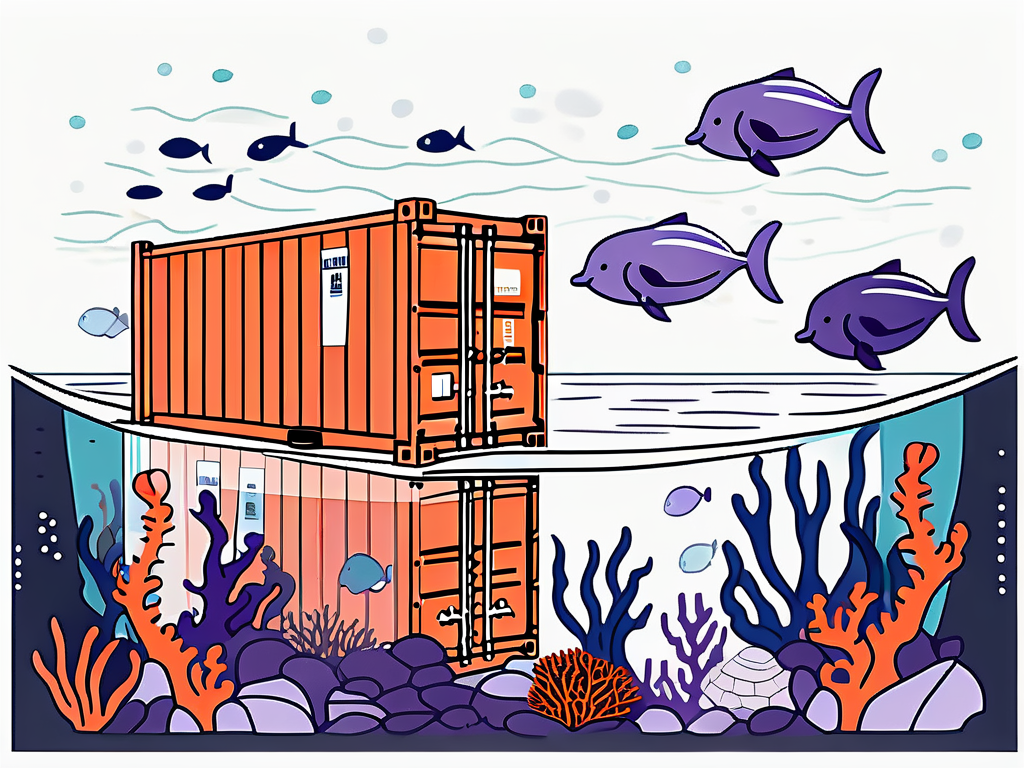Every year, thousands of shipping containers end up in the ocean. These massive containers, used to transport goods across the world, have a curious property—they can either float or sink.
Let’s dive into the fascinating world of shipping containers and find out if they float or sink when they end up in the ocean. Here’s what our main points in this article will be:
- The role of design in the buoyancy of shipping containers
- Floating and sinking science
- Factors affecting the buoyancy of shipping containers
- What happens with lost shipping containers
- Safety measures that prevent the loss of containers
Table of Contents
ToggleThe Design of Shipping Containers Determines Whether They Float or Sink
Shipping containers can float for a while due to their watertight and airtight construction, but they will eventually sink if filled with water or damaged.
Statistically, it’s estimated that around 10,000 shipping containers are lost at sea each year, indicating that while they may float temporarily, they are not designed to remain buoyant indefinitely.
The design of a shipping container is carefully engineered to ensure stability and safety during transportation. Businesses utilizing ocean freight and international fulfillment services must consider container integrity and weight distribution to prevent accidents at sea. The container’s shape and dimensions are optimized to fit securely on cargo ships and intermodal transport vehicles. These considerations come into play when determining the container’s buoyancy.
Material and Construction of Shipping Containers
Shipping containers are constructed using high-quality steel, which provides strength and structural integrity. The steel is then treated with anti-corrosive coatings to protect against rust and damage caused by seawater.
The construction process involves welding the steel plates together to form a watertight shell. Reinforcements are added to key areas to enhance structural strength.
This meticulous construction ensures that the container can withstand the rigors of marine transportation and potentially stay afloat in case of an accident.
Furthermore, the steel used in shipping container construction undergoes rigorous testing to ensure its quality and durability. It is subjected to various stress tests, including simulations of extreme weather conditions and exposure to corrosive elements.
This testing ensures that the containers can withstand the harshest of environments and maintain their structural integrity over time.
The Role of Buoyancy in Container Design
When it comes to buoyancy, the design of a shipping container takes into account various factors. One of the key principles at play is buoyant force, which depends on the density of the container and the surrounding water.
A container will float if the weight of the air inside and the contents it carries is less than the weight of the water it displaces. If the weight is greater, the container will sink. To achieve the desired buoyancy, the container’s weight, volume, and distribution must be carefully considered and controlled.
Additionally, the design of shipping containers incorporates features that enhance their buoyancy. For example, some containers have built-in air chambers that increase their overall volume and buoyant force.
These air chambers act as additional flotation devices, ensuring that the container remains afloat even if it becomes partially submerged.
Moreover, the placement of cargo within the container is also taken into account to optimize buoyancy. Distributing the weight evenly throughout the container helps maintain its stability and ensures that it floats properly.
This careful consideration of weight distribution is crucial, especially when transporting heavy or unevenly distributed loads.
The Science Behind Floating and Sinking
The science behind whether a shipping container floats or sinks involves two fundamental principles: density and displacement. Understanding these principles is key to comprehending the complex interaction between the container and the surrounding water.

When it comes to the density of a shipping container, it’s not just about the material it’s made of, but also about how it’s packed.
For example, a container filled with lightweight materials like Styrofoam will have a lower overall density compared to one filled with dense metals. This difference in density will determine the container’s ability to float or sink in water.
Principles of Density and Displacement
Density refers to how much mass an object has in relation to its volume. In the case of a shipping container, the density determines whether it will float or sink. If the density of the container is less than the density of the water it displaces, it will float. If the density is greater, it will sink.
Displacement, on the other hand, refers to the volume of water that is pushed aside by the container when it is submerged. The amount of water displaced affects the buoyant force exerted on the container.
When a shipping container is placed in water, it displaces an amount of water equal to its own volume. This displaced water creates an upward force known as buoyancy, which counteracts the downward force of gravity. If the buoyant force is greater than the weight of the container, it will float; if it’s less, the container will sink.
How Weight Distribution Affects Buoyancy
The distribution of weight within a shipping container greatly influences its buoyancy. If the weight is evenly distributed, the container is more likely to float. However, if the weight is concentrated in one area, it can cause the container to tilt and potentially sink.
Shipping companies take great care in ensuring that containers are loaded and secured properly to maintain stability and prevent accidents at sea. Weight distribution plays a vital role in the safety and buoyancy of the containers as they travel across the vast oceans.
Furthermore, the shape of a shipping container also plays a role in its ability to float. A container with a wider base will have more stability in the water compared to one with a narrow base.
This is why most shipping containers have a rectangular shape, providing a good balance between storage capacity and buoyancy.
Factors Affecting the Buoyancy of Shipping Containers
Several factors can influence the buoyancy of shipping containers, making it a complex matter to predict whether they will float or sink. Let’s explore some of these factors in more detail.
Understanding the buoyancy of shipping containers involves considering not only their weight and cargo load but also the design and construction of the containers themselves.
The materials used, the shape of the container, and even the presence of any air pockets inside can all play a role in determining whether a container will float or sink in water.
Impact of Container Load
The weight of the cargo inside a shipping container significantly affects its buoyancy. A heavily loaded container may be more prone to sinking, especially if the weight is unevenly distributed. Businesses managing heavy shipments can use a big item delivery service to ensure secure transportation of oversized goods.
Container ships have specific weight limits and guidelines to ensure the safe transportation of goods. These restrictions help maintain the overall stability of the ship and reduce the risk of containers sinking during transit.
Furthermore, the type of cargo being transported can also influence buoyancy. For example, containers carrying goods that are less dense and more buoyant, like certain types of plastics or wood, may have different floating characteristics compared to containers filled with denser materials like metal or stone.
Effect of Water Ingress
Water ingress, or the entry of water into the container, can also impact its buoyancy. If water gains access to the interior of the container, it can increase its weight, potentially causing it to sink.
Safeguarding against water ingress is a crucial aspect of container design and maintenance. Proper sealing and regular inspections help minimize the risk of water penetrating the container and compromising its buoyancy.
Additionally, the temperature of the water in which the container is floating can affect its buoyancy. Warmer water is less dense than colder water, which means a container may float differently depending on the region it is traversing.
Factors such as currents, waves, and even the salinity of the water can all contribute to the complex interplay of forces that determine whether a shipping container will remain afloat or succumb to the depths.
The Fate of Lost Shipping Containers
Despite all the precautions, accidents still happen, and shipping containers are occasionally lost at sea. The environmental impact of these sunken containers and efforts to recover them have become important topics of discussion.

When a shipping container is lost at sea, it can sink to the ocean floor, becoming part of a hidden underwater world. These containers may rest on the seabed for years, slowly becoming artificial reefs for marine organisms.
Over time, corals, sponges, and other sea creatures attach themselves to the metal surfaces, creating a new ecosystem in the depths of the ocean.
The Environmental Impact of Sunken Containers
Lost shipping containers can pose a threat to marine ecosystems. The materials used in their construction, such as steel and potentially hazardous cargo, can have long-lasting effects on marine life and habitat.
Furthermore, the process of corrosion can release toxic substances into the surrounding water, impacting the health of marine organisms.
The presence of these sunken containers can also alter the natural sedimentation patterns on the ocean floor, affecting the distribution of nutrients and creating localized environmental changes.
Additionally, the presence of sunken containers on the ocean floor can disrupt natural underwater ecosystems and pose obstacles to marine navigation and fishing activities.
Recovery and Salvage of Lost Containers
Efforts to recover lost shipping containers involve specialized equipment and techniques. Divers and submersible vehicles are employed to locate and retrieve containers from the seafloor. Salvage operations are important to minimize the environmental impact and ensure the safety of maritime activities.
Salvage teams face challenges such as strong currents, low visibility, and the structural integrity of the containers themselves. The recovery process requires careful planning to prevent further damage to the marine environment during retrieval.
Once recovered, the containers are often recycled or properly disposed of to reduce their impact on the ocean ecosystem.
Safety Measures to Prevent Container Loss at Sea
Prevention is always better than cure, and measures are in place to mitigate the risk of container loss at sea. Let’s explore some of these safety measures.
Container Securing and Stacking Techniques
To prevent containers from shifting or falling overboard during rough seas, they are secured and stacked using specialized methods. Proper stowage is an essential part of what is logistics planning, ensuring shipments reach their destination safely and efficiently. Twist locks, lashing bars, and heavy-duty chains are used to fasten the containers to the ship’s deck and to each other, ensuring stability and safety.
Furthermore, modern container ships are equipped with advanced technology such as automated stacking cranes and computerized systems that monitor the stability of the cargo.
These technological advancements have significantly improved the efficiency and safety of container stowage, reducing the risk of accidents and losses at sea.
Role of Weather Forecasting in Shipping Safety
Accurate weather forecasting plays a crucial role in shipping safety. Timely data and how can real-time inventory improve supply chain efficiency can help companies track cargo movement and prevent unexpected losses.
Moreover, the use of satellite technology and weather modeling software has enhanced the accuracy of weather predictions, providing real-time data to ships at sea.
This proactive approach enables vessels to adjust their speed and course to navigate around inclement weather, minimizing the chances of container loss and ensuring the safety of crew members and cargo.
With Yearly Innovations, Ocean Transportation of Goods Becomes More and More Safe
In conclusion, whether shipping containers float or sink depends on a combination of factors, including design, weight, density, and distribution. Understanding the science behind buoyancy helps ensure the safe transportation of goods across the vast oceans.
As we continue to innovate in container design and safety measures, the impact on the environment and the safety of maritime activities remain top priorities. If you’re looking for expert logistics solutions, contact us to see how we can help optimize your supply chain.






